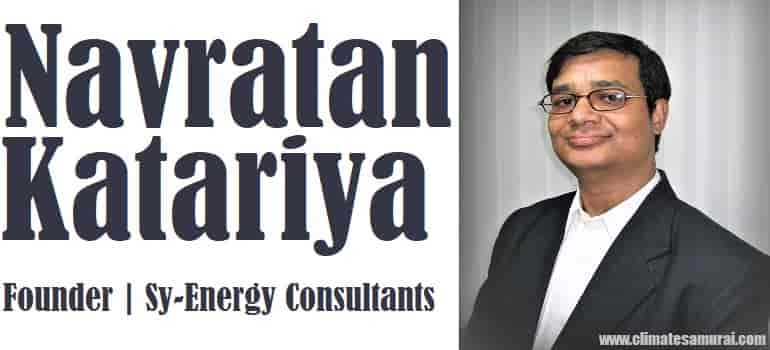 Thank you Mr. Navratan Katariya for your time, please share with our readers about the Sy-Energy Consultants and what has been the motivation behind?
Thank you Mr. Navratan Katariya for your time, please share with our readers about the Sy-Energy Consultants and what has been the motivation behind?
Sy-energy Consultants offer consulting services and innovative solutions in the realm of renewable energy and IoT. Starting from project conception to project execution and moving on to offering advice on Operation and Maintenance aspects, Sy-energy recommends cost-effective and quality solutions. It has helped in areas of strategy, investments, M&A, Owners and lenders engineering, Techno-commercial Due-diligence and capability building for its clients.
The passion for renewable energy and the opportunity to give something back to the ecosystem pushed me to initiate this.
What have been the challenges in your journey so far?
At a level of consulting requiring long and deep techno-commercial experience, scalability is a challenge for the business. Also, while building capability, a consultant eventually reduces longevity of his consulting business with the client, – but that is what capability building is about! Added are the price sensitivity of the renewable projects under development. Non-cost related areas for quality improvement, from design, procurement and execution have been most sought after to me by the clients.
You have experience of 14 startups of new businesses over 2 plus decades, in solar, wind and engineering. Please tell how your company is helping entrepreneurs as well as existing companies to get into solar as a business
We take a Holistic approach: from developing people and company-wide skills in sales, design, procurement, execution, the focus remains multifunctional capability enhancement, for both the existing and new companies. The Multi-functional (e.g. sales team to learn preliminary site designs and costing, economics) and multi-disciplinary skills (electrical, mechanical with solar engineering) are the recommended areas of building capability within the client’s team. Innovation in almost every field, from engineering to marketing interactions – helps in this competitive industry to achieve a balance between quality and price. Fortunately, the good clients understand the importance of this balance for a project which lasts 25 years.
What do you feel is the biggest barrier to mass adoption of solar PV technology, specifically the rooftop segment?
Maturity of industry players, low entry barrier to become a system integrator and heavy competition /under cutting prices will take some time to settle. Difficulty in raising capital for SMEs/apartment complex for rooftop, and DISCOM approvals/oppositions are other barriers. A SME often prefers to invest into a new lathe machine than explore lowering opex in power bills. Opex models have been now taking off, especially with vendors who bring low cost debt/ investments; but I would see capex investment to continue to be leading over opex.
What one Should Know Before they Choose to be a ‘System Installer
As a new entrant to be a system installer, the usual questions one should ask self is why he/she is entering into it and what is the USP they bring to this eco-system which makes them stand apart. They should have one or more of the following capabilities: engineering, execution, marketing / connections, financial capability, brand (existing for those who are diversifying into solar).
If you were able to implement any solar panel incentive program you want in India, what would that program look like?’
Subsidizing working capital based on volume and vertical integration depth of existing and new entrants in module manufacturing will hopefully work on a short run. On a long term basis, semiconductor, and manufacturing engineering capability enhancement in India is a must. A long committed market for solar modules e.g., on the lines of long term PPA could also be another option for investors to mitigate future market risks.
Did the India solar sector already reached its low in tariffs or is there any further scope Or will there be reverse trend in solar tariffs?
Improvement in efficiency and manufacturing cost reduction, thru technology disruption may happen in a 5 year span, but the inflationary cost of BOS (Balance of Systems) and labour etc. would have compensated such reductions. Innovation is due in hybrid (multi power sources), water surface projects, storage and evacuation; which should get us some yet untapped market. My guess is that a non-firm power source like solar, wind has already seen a flattened tariff or LCOE.
What is your opinion on the anti-dumping and safeguard duties? Do India really needs it, will this really slow down solar installation?
Indeed, any interruptive policy decisions will slow and much worse, move investments away in future. Tax, levies, duties, whether central or state governments on equipment, labour, energy should have a long term firmness across political systems/cycles of governance. Open access related charges’ variance, e.g. are already making the large captive and IPP market nervous and these should be seriously looked into. ISA (International Solar Alliance) brings some good hope for Indians solar stakeholders becoming global players.
(This Interview was originally published in May issue of Climate Samurai)

